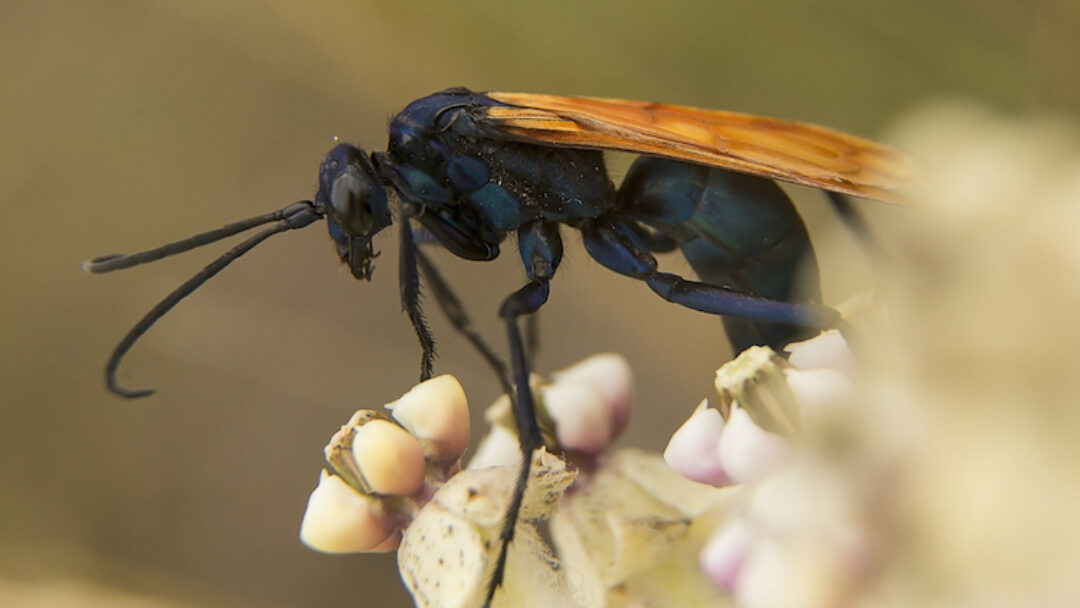By Lauren Wong
As beautiful as Arizona is, we have to remember we’re not the only ones roaming its terrain. From desert to mountains, canyons, and valleys, Arizona houses a vast range of landscape types. Known for its dry, hot, low-elevation deserts, it may be surprising to hear that over half the state lies at least 4,000 feet above sea level. Humphreys Peak, the highest point in the state, reaches over 12,000 feet.
You can be tanning at the pool during the winter months in Phoenix, then drive up state and go skiing that same day. Diverse in altitude, temperatures, and landscape, it makes sense why so many critters call this state their home. However, when a place has such a broad scope of species, it’s more susceptible to house some that can inflict danger.
Hopefully you’ll never find yourself in a vulnerable situation with any of the following animals, but on the off chance that you do, it’s smart to know how to react. Go out, hike, and enjoy the stunning views around every bend in Arizona with peace of mind that in the worst case scenario, you’re prepared and you know exactly what to do.
Here’s a list of some of Arizona’s most dangerous species to look out for.
Arizona Bark Scorpion
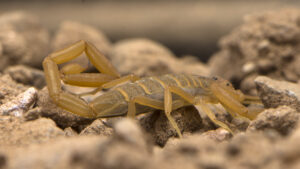
Where: Sonoran Desert
Identifying features: With a tan body and slightly darker backs, these scorpions are usually no bigger than 2.5 inches. Being nocturnal, they typically only come out at night and will glow bright blue under a UV light.
The Arizona Bark Scorpions are the most venomous species of scorpions that live in the United States. That being said, don’t panic, some only experience pain. Experiencing an allergic reaction is typically what increases your risk, but it’s very rare for a sting to be fatal.
To avoid stumbling across any species of scorpions while living in Arizona, keep your grass mowed, remove piles of rocks or lumber from around your house, caulk cracks, and be sure to shake out clothing, boots, etc. They tend to avoid contact with humans but if stung, you can call your local poison control center for advice on what to do. Children should always get immediate medical care if stung along with anyone else who experiences severe symptoms.
Some common symptoms to look out for include pain where/near you were stung, numbness or tingling in the area, muscle immobility, vomiting, nausea, difficulty breathing. Severe symptoms include paralysis, foaming at the mouth, and seizure-like symptoms.
Black Bears
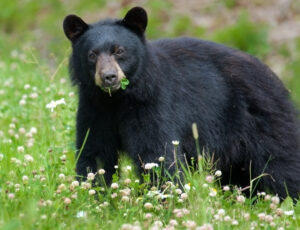
Where: Most woodland habitats (typically at elevations 4,000 to 10,000 feet)
Identifiable features: Since it’s the only bear that’s found in Arizona, any encounter with a bear is a black bear. Weighing 125 – 400 pounds, their fur coat varies from black to dark blond. If you come across a five to seven inch long paw print, you can safely assume you’re sharing the trail with a black bear.
Food is the key factor that creates conflicts among bears and humans. Anything left out can attract them whether that’s to your campsite, or household garbage can. Contrary to what you may think, these big burly animals are likely more scared of you than you are of it. That being said, they’re still unpredictable wild animals that should not be approached.
If you do find yourself in a confrontation with one, don’t run or play dead, instead, make yourself appear as big as you can. Make as much loud noise as possible and slowly back away.
Gila Monsters
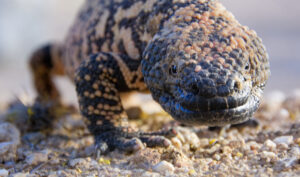
Where: Western and Southern Arizona
Identifying features: A bright pink or orange bumpy-skinned lizard that can grow up to 18 – 22.5 inches in length, and weighs 3 – 5 pounds. It has a short fat tail and a large head with small beady eyes.
If you see a Gila Monster do not attempt to approach it. These venomous lizards are not out to attack you, the only time they’ll react is if they feel threatened. Them hissing or slightly backing away is indication that they feel threatened by you and could be preparing to attack.
Bites are rarely life-threatening, but you should seek medical attention right away. Venom that’s released in its bite can cause swelling to the cut, burning pain, vomiting, dizziness, and weakness. It can also increase your heart rate and lower your blood pressure. Try to remain as calm as possible, if it hasn’t released its grip, lower it down to ground level. With its feet on the ground the Gila Monster is more likely to feel safe and let go, otherwise, use a stick or some other object to pry open its mouth. It’s crucial to not constrict the wound with a bandage or tourniquet. Do not apply ice, just get to a doctor as soon as possible and try to keep the bitten area immobilized and below heart level.
Kissing Bugs
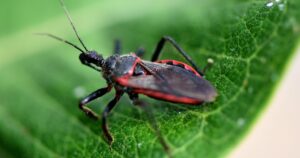
Photo Credit: /www.healio.com/news/cardiology
Where: Sonoran Desert, mostly present during May and June
Identifying features: Around a quarter of an inch in size, they’re pretty easy to identify. Their bodies are primarily brown and black with orange, yellow, or red stripes on the edge of their wings. Their heads are elongated and cone-shaped.
These bugs can make their way into homes through cracks or open doors and usually hide in dark areas. Feeding on the blood of vertebrates, mostly rats, they’ll feed on humans, dogs, and livestock at a given opportunity. As summer rolls around and temperatures are on the rise, the beginning of the monsoon season is traditionally the peak of reported human bites. Since their bites are painless, and usually occur when people are sleeping, they won’t necessarily know they’ve been bitten until they wake up with swelling and inflammation.
Allergic reactions are caused by the kissing bug’s saliva and can cause shortness of breath, low blood pressure, dizziness, a skin rash, and generalized itchiness. If you suspect you’ve been bitten and are showing severe symptoms, go to the nearest emergency medical institution to get it checked out.
The scariest thing about this critter is that they’re carriers of the parasite Trypanosoma Cruzl which causes Chagas disease. Since this is passed in the feces of the bug, or ingestion of the bug, luckily there have been no confirmed cases of this disease. If you come across one in your home, don’t pick it up barehanded.
Mountain Lions

Where: Found throughout Arizona, most commonly in rocky or mountainous terrain
Identifying features: Weighing anywhere from 70 – 150 pounds, these big cats have a tan, reddish brown, or gray coat.
Although your first instinct may be to run, do not. Running will trigger their instinct to chase. As long as you don’t approach these animals they’re known to leave humans alone. Try your best to stay calm and make yourself seem as big as possible; raise your arms, unzip your jacket, stand tall, and wave your arms slowly. Speak loud and maintain eye contact. If there are branches or stones around you that you can reach without turning your back to the lion, try throwing them near it to scare them away. If none of this works, be prepared to fight back. Any sightings should be reported to your local Arizona Game and Fish Department office.
Snakes
Rattlesnakes
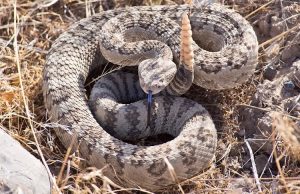
Where: Anywhere with thick ground vegetation across the state
Species: Grand Canyon rattlesnakes, Arizona black rattlesnakes, Mojave rattlesnakes, and prairie rattlesnakes
Identifying features: Up to eight feet in length, these snakes can be identified by their triangular heads and thick, scaly bodies. There are slight differences depending on the species. The biggest tell tale sign is the rattling/clicking sounds it makes.
Rattlesnakes aren’t aggressors, but they’re very defensive. If you spot a rattlesnake, freeze, and slowly move away from it. If you’re hiking, do not attempt to walk past it, let it move away on its own. Although these bites are seldom fatal, the venom is still extremely toxic and you should seek medical attention immediately. Two puncture marks will be visible at the site of the injury from their fangs. Some symptoms include burning pain/tingling at the wound and swelling. You may experience numbness around your body, lightheadedness, an overall feeling of weakness, nausea or vomiting, sweating, salivating, blurred vision, and difficulty breathing.
It’s important to stay as still and calm as possible if you’ve been bit to slow the circulation of venom in your body. If possible, keep the affected area below heart level and remove any tight clothing or jewelry. Don’t try to stop the bleeding. Allowing the cut to bleed allows some of the venom to drain out naturally. Contrary to what you may have seen on television, attempting to suck the venom will introduce new bacteria to the wound and just spread the venom to your mouth. The best thing to do is get to a hospital as soon as possible and let medical professionals take care of you.
Western Coral Snakes
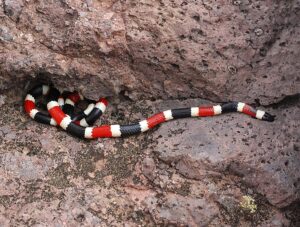
Photo Credit: www.worldatlas.com
Where: Sonoran Desert
Identifying features: These small snakes (13 – 22 inches long) can be as thin as a pencil and are identifiable by their vibrant colors. Wide red and black bands encircle its body with narrow yellow and white rings. If you hear a popping sound, this can be an indication that one is near.
Although their venom is twice as potent as the most venomous rattlesnakes, these snakes usually pose less of a threat to humans. Due to its small size, it generally can’t transmit enough venom to cause you serious harm. Most bites occur from people trying to pick them up or purposely messing with them. Often, you won’t experience symptoms right away, but it’s still crucial to seek immediate medical attention. Eventually this “neurotoxin” that enters your body from a bite can cause slurred speech, double vision, and lead to serious respiratory consequences if enough venom has been inflicted.
Sonoran Desert Toads
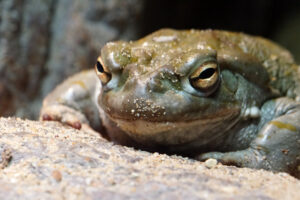
Where: Central Arizona
Identifying features: As one of the biggest toads native to North America, these seven (or more) inch toads can be identified by their green-gray top, and creamy white bottoms. Although their skin is rather smooth, these toads have sizable, white warts at their jaw line, lumps behind the eyes, and on their hind legs.
Sonoran Desert toads surface during monsoon season. These animals raise a higher threat to your pets than they do for you. Keep curious pets away from these, as licking or ingesting these can be life threatening if not treated. A toxic substance, bufotoxin, is produced and released from their parotoid glands located behind their eyes. Although a small amount of this toxin on your skin won’t do much harm, it’s better to be safe than sorry and contact poison control. The real threat comes from either ingesting or inhaling it which can cause hallucinations and cardiac dysrhythmias.
Spiders
Arizona Brown Spider
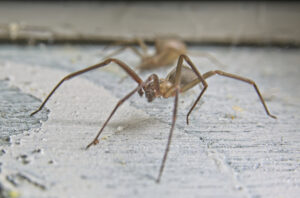
Where: Can be seen in urban areas, but mostly found in desert areas
Identifying features: There are two species of these two-toned, tan and gray bodied spiders. They have a dark brown marking on the front part of their body that resembles a violin. These spiders are less than an inch long and have three pairs of eyes that are bow-shaped across its top.
Since it is hard to identify a spider’s species by a glance, if you suspect you’ve been bitten by an Arizona brown spider contact poison control immediately. You may not feel any symptoms at first, but as time goes on blisters are likely to form at the bite. Symptoms from these venomous bites also include fever and nausea.
Black Widow Spider
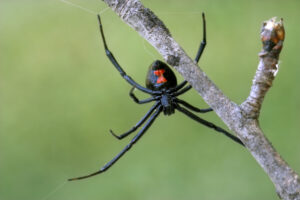
Where: Phoenix’s urban and desert areas
Identifying features: Male, female, and newly hatched black widows all have slightly different looks, but they are all venomous. Be on the lookout for a glossy-black spider with a bright orange/red hourglass-shaped marking and a tan spider with the same markings. Newly hatched black widows are white, have black spots and a cream-colored hourglass. With legs extended they can be up to two inches in size.
Generally these bites aren’t fatal, but they’re still very dangerous so poison control should be contacted immediately. What makes these bites threatening, is that their venom is a nerve toxin, meaning it’s impacts are to your nervous system. This can cause difficulty breathing, and progressive muscle pain.
Tarantula Hawk
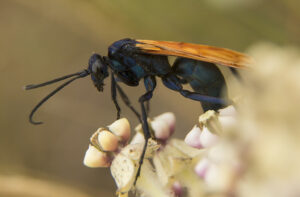
Where: Sonoran Desert area
Identifying features: Growing up to two inches long in size, these insects have a large dark body, bright reddish-orange wings, long legs, and hooked claws.
Unless handled, these wasps are typically not aggressive and won’t sting you. Don’t agitate them by trying to swat them away. According to the Schmidt Sting Pain Index, their stings are known to be the most painful stings in North America and the second most painful in the world. The pain should subside in less than five minutes, but it’s been described as an intense debilitating, electrifying, and excruciating pain. To prevent further injury, if you’re stung you should sit or lay down immediately until the discomfort fades. Alleviate pain and swelling by applying a cold compress or ice to the affected area. A topical cortisone-or antihistamine can be used to relieve itching.


